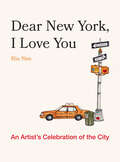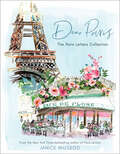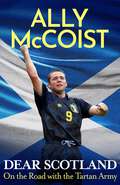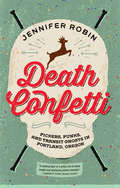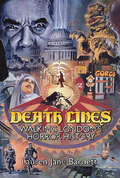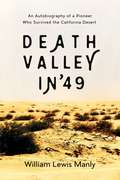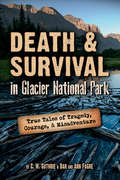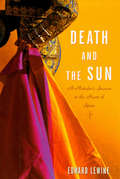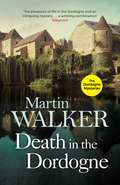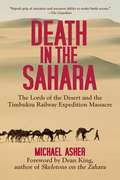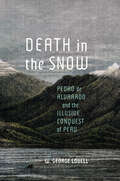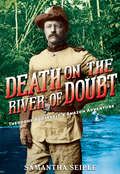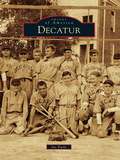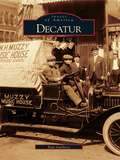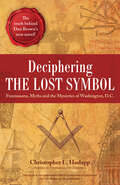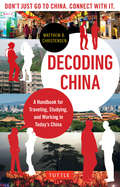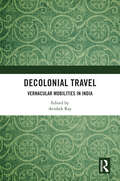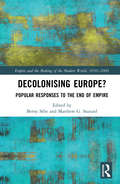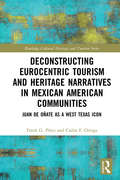- Table View
- List View
Dear Los Angeles: The City in Diaries and Letters, 1542 to 2018
by David KipenA rich mosaic of diary entries and letters from Marilyn Monroe, Cesar Chavez, Susan Sontag, Albert Einstein, and many more, this is the story of Los Angeles as told by locals, transplants, and some just passing through.“Los Angeles is refracted in all its irreducible, unexplainable glory.”—Los Angeles Times The City of Angels has played a distinct role in the hearts, minds, and imaginations of millions of people, who see it as the ultimate symbol of the American Dream. David Kipen, a cultural historian and avid scholar of Los Angeles, has scoured libraries, archives, and private estates to assemble a kaleidoscopic view of a truly unique city. From the Spanish missionary expeditions in the early 1500s to the Golden Age of Hollywood to the strange new world of social media, this collection is a slice of life in L.A. through the years. The pieces are arranged by date—January 1st to December 31st—featuring selections from different decades and centuries. What emerges is a vivid tapestry of insights, personal discoveries, and wry observations that together distill the essence of the city. As sprawling and magical as the city itself, Dear Los Angeles is a fascinating, must-have collection for everyone in, from, or touched by Southern California. With excerpts from the writing of Ray Bradbury • Edgar Rice Burroughs • Octavia E. Butler • Italo Calvino • Winston Churchill • Noël Coward • Simone De Beauvoir • James Dean • T. S. Eliot • William Faulkner • Lawrence Ferlinghetti • Richard Feynman • F. Scott Fitzgerald • Allen Ginsberg • Dashiell Hammett • Charlton Heston • Zora Neale Hurston • Christopher Isherwood • John Lennon • H. L. Mencken • Anaïs Nin • Sylvia Plath • Ronald Reagan • Joan Rivers • James Thurber • Dalton Trumbo • Evelyn Waugh • Tennessee Williams • P. G. Wodehouse • and many moreAdvance praise for Dear Los Angeles“This book’s a brilliant constellation, spread out over a few centuries and five thousand square miles. Each tiny entry pins the reality of the great unreal city of Angels to a moment in human time—moments enthralled, appalled, jubilant, suffering, gossiping or bragging—and it turns out, there’s no better way to paint a picture of the place.”—Jonathan Lethem“[A] scintillating collection of letters and diary entries . . . an engrossing trove of colorful, witty insights.”—Publishers Weekly (starred review)
Dear New York, I Love You: An Artist's Celebration of the City
by Ria SimEnjoy 120 colorful sketches that remind even the most jaded New Yorkers to notice the city’s simple beauties. Ria Sim, the creator of the popular Instagram account @coffeecakescafe, might be New York City’s biggest fan. She herself describes New York City as her soulmate (though it started out as just a crush when she lived in the Bay Area). Now a full-time Manhattan resident, Ria sees the best in the city: she’s moved by the simplicity of the buildings against the sky, a single flower on a not-so-clean sidewalk, and the ever-rotating, meticulously curated decorations adorned on a brownstone in the West Village. She draws everything from local landmarks like Joe’s Pizza and the Stonewall Inn to strangers’ doorsteps and snow-covered yellow cabs. Dear New York, I Love You allows you to see New York through Ria’s eyes and in all seasons—it’s a colorful celebration, a love letter, and a beautiful art book all in one.
Dear Paris: The Paris Letters Collection
by Janice MacLeodEat, Pray, Love meets Claude Monet in this epistolary ode to the French capital from the New York Times–bestselling author of Paris Letters.What started as a whim in a Latin Quarter café blossomed into Janice MacLeod’s years-long endeavor to document and celebrate life in Paris, sending monthly snippets of her paintings and writings to the mailboxes of ardent followers around the world. Now, Dear Paris collects the entirety of the Paris Letters project: 140 illustrated messages discussing everything from macarons to Montmartre.For readers familiar with the city, Dear Paris is a rendezvous with their own memories, like the first time they walked along the Champs-Élysées or the best pain au chocolat they’ve ever tasted. But it’s about more than just a Paris frozen in nostalgia; the book paints the city as it is today, through elections, protests, and the World Cup—and through the people who call it home. Wistful, charming, surprising, and unfailingly optimistic, Dear Paris is a vicarious visit to one of the most iconic and beloved places in the world.Praise for Paris Letters“Janice MacLeod’s charming Paris Letters takes us on her starry-eyed discovery of Paris, the joys of learning the French language, a unique career in art and, best of all, the romance of a lifetime! C’est bon!” —Lynne Martin, author of Home Sweet Anywhere“Written as though to a best friend telling her story over lattes—or café crème. Relatable and inspiring . . . cleverly crafted with wit and unexpected wisdom.” —New York Journal of Books
Dear Scotland: On the Road with the Tartan Army
by Ally McCoistThe Tartan Army. The Hampden Roar. The Auld Enemy. Following Scotland can be a thrilling, heart-breaking, and exhilarating experience. Scottish legend AllyMcCoist has always been proud of his country's footballing legacy. After all, Scotland has the oldest international team and the oldest sporting trophy. Some even say Scotland is the true home of football... In Dear Scotland, Ally takes the reader on an unforgettable journey through the Alba. He spends time with the best fans in the world, celebrates legends like Jock Stein and Kenny Dalglish, and relives some of the most iconic moments in Scottish history. Reflecting on his own call up with the team and scoring that goal against Switzerland, to dressing room antics on tour and travelling with the Tartan Army, Ally recalls the memorable characters, unforgettable moments, and side-splitting stories that have shaped his own experiences. Dear Scotland is a hilarious and heartfelt love letter and a tribute to being a lifelong, and sometimes long-suffering, footy fan. It reminds us why we love the thrill and madness of following Scotland.
Dear Scotland: On the Road with the Tartan Army
by Ally McCoist**Out now: the hilarious and heartfelt book from Scottish footballing legend, Ally McCoist**__________The Tartan Army. The Hampden Roar. The Auld Enemy. Scotland has a proud footballing history, steeped with passion and tradition. Scottish legend Ally McCoist has always been proud of his country's footballing legacy. After all, it's a country with the oldest international team and the oldest sporting trophy. Of course, Scotland is the true home of football... In Dear Scotland, Ally takes the reader on an unforgettable journey through the Alba. With the best fans in the world, legendary players like Davie Cooper and Kenny Dalglish, and some of the the most iconic moments in international football, this is a celebration of what it means to follow the Scottish team. From his call up and debut and scoring that goal against Switzerland, to dressing room antics on tour and travelling with the Tartan Army, Ally recalls the memorable characters, unforgettable moments, and side-splitting stories. Dear Scotland is a hilarious and heartfelt love letter and a tribute to being a lifelong Scotland fan, reminding you why you love the thrill and madness of following Scotland.
Death Confetti: Pickers, Punks, and Transit Ghosts in Portland, Oregon
by Jennifer RobinWith savage humor, Death Confetti features performance artist Jennifer Robin's autobiographical sketches of Portland, Oregon, from the grunge-era obscurity of the '90s to its current media-darling status.As an only child raised by reclusive grandparents in upstate New York, Jennifer recalls that she felt "anemic for the real." At seventeen she broke loose and made her way to the west coast."Civilization is a nightmare-illusion," Jennifer writes, "a three-dimensional spreadsheet perpetuated by machines that hypnotize meat."In a city that's stranger than fiction, grocery-store checkers and meth-heads loom as lost gods. We're introduced to the lady tweaker "Chew Toy," who wears moon boots and sings hair metal songs all night as she collects recyclable bottles. Jennifer visits a bar where executives simulate doggie-style sex acts on the dance floor. Then there's all the tales of late-night life on the city's buses and light rail.Jennifer reflects on her early terror in Catholic school and phone calls with her far-out mother, who disclosed that her gynecologist was a murderer. In the all-too-true pages of Death Confetti, Robin remembers her life among noise musicians, junkies, and her escape from a boyfriend who insisted on reviving the lives of hundreds of deceased fruit flies.Death Confetti jolts the senses, and lingers like a mosquito bite to the Portland of everybody's soul.
Death Lines: Walking London's Horror History
by Lauren BarnettThe first walking guide to London&’s role in the evolution of horror cinema, inspired by the city&’s dark histories and labyrinthine architectures.Death Lines is the first walking guide to London&’s role in the evolution of horror cinema, inspired by the city&’s dark histories, labyrinthine architectures, atmospheric streetscapes, and uncanny denizens. Its eight walks lead you on a series of richly researched yet undeniably chilling tours through Chelsea, Notting Hill, Westminster, Bloomsbury, Covent Garden, and the East End, along the haunted banks of the river Thames, and down into the depths of the London Underground railway. Each tour weaves together London&’s stories and takes the reader to magnificent, eerie, and sometimes disconcertingly ordinary corners of the city, unearthing the literature, legends, and history behind classics like Peeping Tom and An American Werewolf in London, and lesser-known works such as mind-control melodrama The Sorcerers; Gorgo, Britain&’s answer to Godzilla; tube terror Death Line; and Bela Lugosi's mesmeric vehicle The Dark Eyes of London. Tinged with humor, social critique, and more than a few scares, Death Lines delights in revealing the hidden and often surprising relationship between the city and the dark cinematic visions it has evoked. Whether read on the streets or from the comfort of the grave, Death Lines is a treat for all cinephiles, horror fans, and lovers of London lore.
Death Undercover: Bruno investigates a violent local murder with international consequences (The Dordogne Mysteries #7)
by Martin WalkerPREVIOUSLY PUBLISHED AS CHILDREN OF WAR'SO LIKEABLE IS BRUNO AND SO CONVINCING HIS MILIEU THAT I WAS DESPERATE FOR MORE ... FORMIDABLE!' Independent on SundayBruno, Chief of Police, France's favourite cop, is under pressure once again in this internationally bestselling series. He's investigating a murder - but it's one his bosses would rather he left well alone...Bruno, Chief of Police in the charming French town of St Denis, is already busy with a case when the body of an undercover French Muslim cop is found in the woods, a man who called Bruno for help only hours earlier. But Bruno's sometime boss and rival, the Brigadier, doesn't see this investigation as a priority - there are bigger issues at stake. Bruno has other ideas. Meanwhile, a Muslim youth named Sami turns up at a French army base in Afghanistan hoping to get home to St Denis. One of Bruno's old army comrades helps to smuggle Sami back to France, but the FBI aren't far behind. Then an American woman appears in St Denis with a warrant for Sami's extradition. Bruno must unravel these multiple mysteries, amidst pressure from his bosses, and find his own way to protect his town and its people.
Death Valley in '49: An Autobiography of a Pioneer Who Survived the California Desert
by William ManlyA survivor’s true account of death, despair, and heroism in Death Valley in the heat of the California Gold Rush. At the height of the California gold rush in 1849, a wagon train of men, women, children, and their animals stumbled into a 130-mile-long valley in the Mojave Desert while they were looking for a shortcut to the California coast. What ensued was an ordeal that divided the camp into remnants and struck them with hunger, thirst, and a terrible sense of being lost beyond hope—until a twenty-nine-year-old hero volunteered to cross the desert to get help. This young hero, William Lewis Manly, was one of the survivors of the tragedy, and he lived to tell the tale forty-five years later in this gripping autobiography, first published in 1894. In a time of unmarked frontiers and wilderness, Manly lived the true life of a pioneer. After being hit by gold rush fever Manly joined the fateful wagon train that would get swallowed up by the barren, arid, hostile valley with its dry and waterless terrain, unearthly surface of white salts, and overwhelming heat. Assaulted and devastated by the elements, members of the camp killed their emaciated oxen for food, ran out of water, split up, and lost and buried their own kind who perished. When Manly’s remaining band of ten came across a rare water hole, he and a companion, John Rogers, left the rest by the water and crossed the treacherous Panamint Mountains and Mojave Desert by themselves in search for rescue. In a true act of heroism against all odds, the two finally returned twenty-five days later with help, rescuing their compatriots, including four children, even when it seemed all hope was lost. Told at the end of the nineteenth century, Manly’s compelling and stirring account brings alive to modern-day readers the unimaginable hardships of America’s brave pioneers, and a chapter in Californian history that should not be forgotten.
Death and Events: International Perspectives on Events Marking the End of Life (Routledge Advances in Event Research Series)
by Ian R LamondThis unique volume examines death from a socio-cultural events perspective. Drawing on the empirical and conceptual work produced by an international body of researchers, it is the first publication to look at death, dying, memorialization, and their mediation, from an events orientation. By placing the contribution of these scholars together, this book provides a unique opportunity to instigate an international, critical discussion, around the connectivities associated with death and events. Chapters consider connections to death and events on many levels, including individual, local, communally based, construals of the event landscape; the relationship between death and events into larger socio-cultural frames of reference. Chapteres also consider how death and events are manifest through diverse platforms of mediation, with a discussion of the media presentation of end of life events, and the articulation of death online. Case studies from a wide-ranging selection of countries, from Moscow to Bangladesh to Cambodia, are examined throughout. This will be of great interest to upper-level students and researchers in event studies as well as a variety of other disciplines such as sociology and cultural studies.
Death and Survival in Glacier National Park: True Tales of Tragedy, Courage, and Misadventure
by C. W. Guthrie Ann Fagre Dan Farge<p>Sheer cliffs, avalanches, turbulent rivers, cold lakes, severe weather, grizzly bears - these are just a few of the ways you can die while visiting Glacier National Park. <p>Since 1910 when the park was established, 296 people have perished within Glacier's boundaries, and many more somehow survived close calls with death. Death and Survival in Glacier National Park recounts their true tales, as well as stories of the brave and often heroic search-and-rescue professionals who put their lives on the line so that others might live. <p>Written by local Glacier National Park experts. Jam-packed with gripping stories of courage and survival against all odds. Featuring the most complete chronology of all 296 deaths in Glacier National Park, including names, ages, locations, and causes.</p>
Death and the Sun: A Matador's Season in the Heart of Spain
by Edward LewinePart sports writing, part travelogue, this is a portrait of Spain, its people, and their passion for a beautiful yet deadly spectacle. A brilliant observer in the tradition of Adam Gopnik and Paul Theroux, Edward Lewine reveals a Spain few outsiders have seen. There's nothing more Spanish than bullfighting, and nothing less like its stereotype. For matadors and aficionados, it is not a blood sport but an art, an ancient subculture steeped in ritual, machismo, and the feverish attentions of fans and the press. Lewine explains Spain and the art of the bulls by spending a bullfighting season traveling Spanish highways with the celebrated matador Francisco Rivera Ordónez, following Fran, as he&’s known, through every region and social stratum. Fran&’s great-grandfather was a famous bullfighter and the inspiration for Hemingway&’s matador in The Sun Also Rises. Fran&’s father was also a star matador, until a bull took his life shortly before Fran&’s eleventh birthday. Fran is blessed and haunted by his family history. Formerly a top performer himself, Fran&’s reputation has slipped, and as the season opens he feels intense pressure to live up to his legacy amid tabloid scrutiny in the wake of his separation from his wife, a duchess. But Fran perseveres through an eventful season of early triumph, serious injury, and an unlikely return to glory.A New York Times Editor&’s ChoicePraise for Death and the Sun&“May be the most in-depth, incisively written guide to bullfighting available in English. Every drunken sophomore riding the rails to Pamplona this summer ought to keep a volume in his backpack.&” —New York Times Book Review&“Lewine demonstrates knowledge of and respect for the matador&’s dangerous profession. E also explores the history of Spaine and the charms and contradictions evident within the country&’s exceptionally varied cultures and people.&” —Boston Globe
Death in the Dordogne: Police chief Bruno's first gripping case (The Dordogne Mysteries #1)
by Martin Walker'HUGELY ENJOYABLE AND ABSOLUTELY GRIPPING. BRUNO ... THE MAIGRET OF THE DORDOGNE - Antony BeevorMillions of readers worldwide are talking about the Dordogne Mysteries. Find out why and discover what dark secrets lurk in the idyllic French town of St Denis in the first book in this acclaimed series.Market day in the ancient town of St Denis in south-west France. EU hygiene inspectors have been swooping on France's markets, while the locals hide contraband cheese in their houses and call the Brussels bureaucrats 'Gestapo'. Local police chief Bruno supports their resistance. Although, here in what was once Vichy France, words like 'Gestapo' and 'resistance' still carry a profound resonance.When an old man, head of an immigrant North African family, is found murdered, suspicion falls on the son of the local doctor, found in flagrante playing sex games surrounded by Nazi paraphernalia.But Bruno isn't convinced, and suspects this crime may have its roots in that most tortured period of recent French history - the Second World War, a time of terror and betrayal that set brother against brother. Now it's up to him to find the killer - but will the people of St Denis allow him to go digging through the past in order to do it?
Death in the Sahara: The Lords of the Desert and the Timbuktu Railway Expedition Massacre
by Dean King Michael AsherDesert explorer Michael Asher investigates the most disastrous exploration mission in the history of the Sahara. In 1880, the French government ordered a surveying expedition for a railway that would bring the fabulous wealth of Timbuktu, in French Sudan, to Paris. This trek should have heralded a new era of French prosperity. Instead, it was a deadly fiasco. Under-armed in hostile territory, and foolishly employing the enemy as guides, the one hundred men of the expedition were ambushed and stranded without camels or supplies in the deserts of southern Algeria. Many were killed outright, and for four months the survivors were menaced by the Tuareg, the lords of the desert, robbed, starved, and tricked into eating poisoned fruit. To escape, the men hid in the wastelands of the Sahara with little hope of finding food or water. They were finally forced to eat their own dead, or, worse, the merely weak. Only a dozen malnourished men lived to tell their tale. The story of their 1,000 mile journey is one of the most astonishing narratives of survival ever recorded. With a superb grip of narrative and uncanny ability to evoke battle scenes (The Guardian), Michael Asher has written an amazing true story that is as dramatic as it is frightening. Skyhorse Publishing, as well as our Arcade imprint, are proud to publish a broad range of books for readers interested in history—books about World War II, the Third Reich, Hitler and his henchmen, the JFK assassination, conspiracies, the American Civil War, the American Revolution, gladiators, Vikings, ancient Rome, medieval times, the old West, and much more. While not every title we publish becomes a New York Times bestseller or a national bestseller, we are committed to books on subjects that are sometimes overlooked and to authors whose work might not otherwise find a home.
Death in the Snow: Pedro de Alvarado and the Illusive Conquest of Peru (McGill-Queen's Iberian and Latin American Cultures Series)
by W. George LovellPedro de Alvarado is best known as the right-hand man of Hernando Cortés in the conquest of Mexico (1519–21) and the ruthless conqueror of Guatemala some years later. Far less known is his intent to intrude in the conquest of Peru and lay claim to Quito, a wealthy domain in the far north of the Inca Empire. To this end, Alvarado constructed a massive fleet, which sailed south from Central America to what is now Ecuador, making landfall on 25 February 1534.Engaging both the European and Indigenous contexts in which Alvarado operated, George Lovell illuminates this gap in the record, narrating a dramatic story of greed and hubris. Upon reaching Ecuador, Alvarado’s formidable entourage – some five hundred Spanish combatants and two thousand Indigenous conscripts – marched from the Pacific coast to the Andean sierra. Though Quito was his intended destination, he never made it. During a treacherous transit across the mountains, Alvarado’s party was engulfed by heavy snowfall and numbing cold, which proved the expedition’s undoing. Those who survived the ordeal discovered that other Spaniards – Diego de Almagro and Sebastián de BeLalcázar, acting in allegiance with Francisco Pizarro – had reached Quito before them, thereby claiming first right of conquest. Believing he had no option, if strife between rival sides was to be avoided, Alvarado sold his costly machinery of war – men, horses, weaponry, and ships – to those who had beaten him to the prize. All but ruined, he returned humiliated to Central America.Death in the Snow brings to light the delusions of one headstrong conquistador and mourns the loss of untold Indigenous lives, casualties of Alvarado’s lust for fame and fortune.
Death on Demand
by Paul ThomasMaori cop Tito Ihaka, "unkempt, overweight, intemperate, unruly, unorthodox and profane ", is a stubborn investigator with an uncanny instinct for the truth. He hunts a shadowy hit-man who could have several notches on his belt, including that of an undercover cop. To complicate matters Ihaka becomes involved with a female suspect who could hold the key to everything.
Death on the Devil's Teeth: The Strange Murder That Shocked Suburban New Jersey (True Crime Ser.)
by Mark Moran Jesse P. PollackRumors, witchcraft, and murder in this true crime account of one of New Jersey&’s most notorious cold cases—from two Weird N.J. magazine contributors. As Springfield residents decorated for Halloween in September 1972, the crime rate in the affluent New Jersey township was at its lowest in years. That mood was shattered when the body of sixteen-year-old Jeannette DePalma was discovered in the woods, allegedly surrounded by strange objects. Some feared witchcraft was to blame, while others believed a serial killer was on the loose. Rumors of a police coverup ran rampant, and the case went unsolved—along with the murders of several other young women. Including extensive interviews with DePalma&’s friends and family, new evidence, and theories about who could have committed this horrible crime, Death on the Devil&’s Teeth provides the definitive account of this shocking cold case more that remains a mystery more than four decades later.
Death on the River of Doubt: Theodore Roosevelt's Amazon Adventure (Scholastic Press Non-fiction Ser.)
by Samantha SeipleThe action-packed true story of President Theodore Roosevelt's dangerous adventure down one of the most treacherous rivers on Earth.Death on the River of Doubt takes readers inside the thrilling journey that unfolds as Theodore Roosevelt and his companions navigate the Amazonian River of Doubt through an unforgiving and unpredictable jungle. With new threats at every turn, from blood-thirsty piranhas and raging rapids to starvation, disease, and a traitor in their own ranks, it seems that not everyone will make it out alive.Through it all, the indomitable Teddy Roosevelt remained determined to complete their mission and rewrite the map of the world. Or die trying.With letters, diary entries, maps, photos, and more, Death on the River of Doubt is a comprehensive narrative nonfiction thriller and the first young adult book to tell this unbelievable tale.
Decatur (Images of America)
by Joe EarleDecatur proudly proclaims itself a city of "homes, schools, and places of worship." While that motto might seem to describe any number of small towns, the words accurately capture the essence of Decatur, a place of fine and humble homes, well-regarded schools, and large, active churches. Founded by the Georgia legislature in 1823 to be the county seat of DeKalb County, Decatur took its name from Commodore Stephen Decatur, a U.S. naval hero of the early 1800s. In the years since, Decatur has grown into a busy suburb of neighboring Atlanta, produced Agnes Scott College, and attracted both the Scottish Rite Children's Hospital and Columbia Theological Seminary. Decatur has been home to fascinating Georgians, including Civil War memoirist Mary Gay and writer Rebecca Latimer Felton, the first woman to be seated as a U.S. senator (if only for a day).
Decatur: 1832-1945 (Images of America)
by Dan GuilloryDecatur, Illinois has long had a proud tradition of workers and craftsmen who produced coal, water pumps, gloves, automobiles, clothing, corn meal, and many other products. Though it is home to Caterpillar's second largest plant and serves as world headquarters for Archer Daniels Midland, a global processor of corn and soybeans, Decatur is much more than jobs and factories. If Illinois is the Heartland, then Decatur is the Heart of the Heartland. Decatur is the site of Abraham Lincoln's first Illinois residence, in 1830, and it is where he was nominated for the presidency on May 10, 1860. Decatur is also home to a symphony orchestra, homes designed by Frank Lloyd Wright, a community college, and Millikin University.
Deciphering the Lost Symbol: Freemasons, Myths and the Mysteries of Washington, D.C.
by Christopher I HodappDiscover the secretive brotherhood behind Dan Brown’s The Lost Symbol in this unauthorized companion book by the author of Solomon’s Builders.Freemason influence on the founding of Washington, D.C., is evident throughout the city’s buildings, statues and monuments—but it’s written in coded symbols that few people understand. Dan Brown’s thriller sends symbologist detective Robert Langdon through the capital to unravel its Masonic secrets. Now in Deciphering The Lost Symbol, Freemason expert Christopher L. Hodapp compares each clue and plot twist in Brown’s story to the true facts.•Discover the meaning of “The Lost Word”•Decode Masonic and alchemical symbolism•Explore the innermost rooms of Masonic lodges and temples•Visit the restricted area of the U.S. Capitol and other landmarks•Uncover secret patterns in Washington, D.C.’s maps and monuments•Crack the codes buried in The Lost Symbol’s artwork and puzzles“Confident in recommending it to everyone, Mason and non-mason alike. This is the perfect a compliment to The Lost Symbol and I feel it should be on the shelf right next to it on your bookcase.” —David Naughton-Shires, Masonic Art Exchange
Decoding China
by Matthew B. ChristensenDo you like to know the unspoken conversations going on around you when visiting other countries? Are you someone who likes to travel on your own terms-from finding that special restaurant to negotiating a better price for a prized antique in a local flea market? If so, Decoding China is the hands-on communication guide for you!Decoding China will teach you the basic "rules of the road" on how to operate in Chinese culture. Like every country, China has its own unique set of cultural "codes," ways of behaving on a daily basis that all Chinese automatically know are the norms. These codes frame every personal interaction in China, and carry with them subtle cultural expectations that the Chinese assume everyone else knows. By learning to recognize these key codes, words and phrases-and using them correctly-then everything you do in China will go a lot more smoothly.By drawing on extensive cultural and linguistic expertise, Dr. Christensen explains the key Chinese cultural codes and how to use these to your advantage. In practical chapters organized by topic, he shows you how to get things done in China, even with very minimal knowledge of the language. Being aware of the cultural norms and a few key words and phrases will give you tremendous confidence, and allow you to "crack the code" and achieve whatever you want. Decoding China will make your China experience work for you, rather than against you, wherever you travel in the country.
Decolonial Travel: Vernacular Mobilities in India
by Avishek RayThis volume brings together scholarship on indigenous forms of travel to decolonize travel theory. It looks at certain minoritarian-vernacular traveling cults – very rarely examined – that compel us to rethink, on the one hand, the conventional tropes of and rationales for travel; and, on the other hand, notions of (post)coloniality, nationalism and modernity in the context of India. The book illustrates the enduring problematic of the ‘colonial episteme’: how it deploys pervasive categories through which travel practices are sought to be understood, and why such categories are inadequate in accounting for the vernacular traveling cults in question. In studying the vernacular world-making in and through these cults, this book offers critical insights on how they defy the log(ist)ics of the ‘imperial categories’ and why they must be read as expressions of decoloniality. An important contribution to travel studies, the book will be an indispensable resource for students and researchers of South Asian studies, travel theory, Indian literary and cultural studies, cultural history and anthropology, sociology, and decoloniality.
Decolonising Europe?: Popular Responses to the End of Empire (Empire and the Making of the Modern World, 1650-2000)
by Matthew G. Stanard Berny SèbeDecolonising Europe? Popular Responses to the End of Empire offers a new paradigm to understand decolonisation in Europe by showing how it was fundamentally a fluid process of fluxes and refluxes involving not only transfers of populations, ideas, and sociocultural practices across continents but also complex intra-European dynamics at a time of political convergence following the Treaty of Rome. Decolonisation was neither a process of sudden, rapid changes to European cultures nor one of cultural inertia, but a development marked by fluidity, movement, and dynamism. Rather than being a static process where Europe’s (former) metropoles and their peoples ‘at home’ reacted to the end of empire ‘out there’, decolonisation translated into new realities for Europe’s cultures, societies, and politics as flows, ebbs, fluxes, and cultural refluxes reshaped both former colonies and former metropoles. The volume’s contributors set out a carefully crafted panorama of decolonisation’s sequels in European popular culture by means of in-depth studies of specific cases and media, analysing the interwoven meaning, momentum, memory, material culture, and migration patterns of the end of empire across eight major European countries. The revised meaning of ‘decolonisation’ that emerges will challenge scholars in several fields, and the panorama of new research in the book charts paths for new investigations. The question mark in the title asks not only how European cultures experienced the ‘end of empire’ but also the extent to which this is still a work in progress.
Deconstructing Eurocentric Tourism and Heritage Narratives in Mexican American Communities: Juan de Oñate as a West Texas Icon (Routledge Cultural Heritage and Tourism Series)
by Frank Perez Carlos OrtegaThis book attempts to dismantle the unfounded Eurocentric view of US-born and immigrant Mexican peoples, that groups together the identities of Latinx, Chicanx, and other indigenous peoples of the Southwest into Hispanics whose contributions to the cultural, historical, and social development of the Southwest are marginalized or made non-existent. The narrative and performative legacies that tourism and fantasy heritage produce are promulgated and consumed by both Latinx and non-Latinx peoples and cultures. This book endeavors to expose these productions through analysis of on-the-ground resistance in the service and spirit of intercultural dialogue and change. This book will offer a precise set of recommendations for breaking away from these practices and thus forming new, veritable identities. With a strongly heritage-oriented discourse, this book on deconstructing Eurocentric representation of Mexican people and their culture will appeal to academics and scholars of heritage tourism, Chicano studies, Southwest studies and Native American studies courses.

